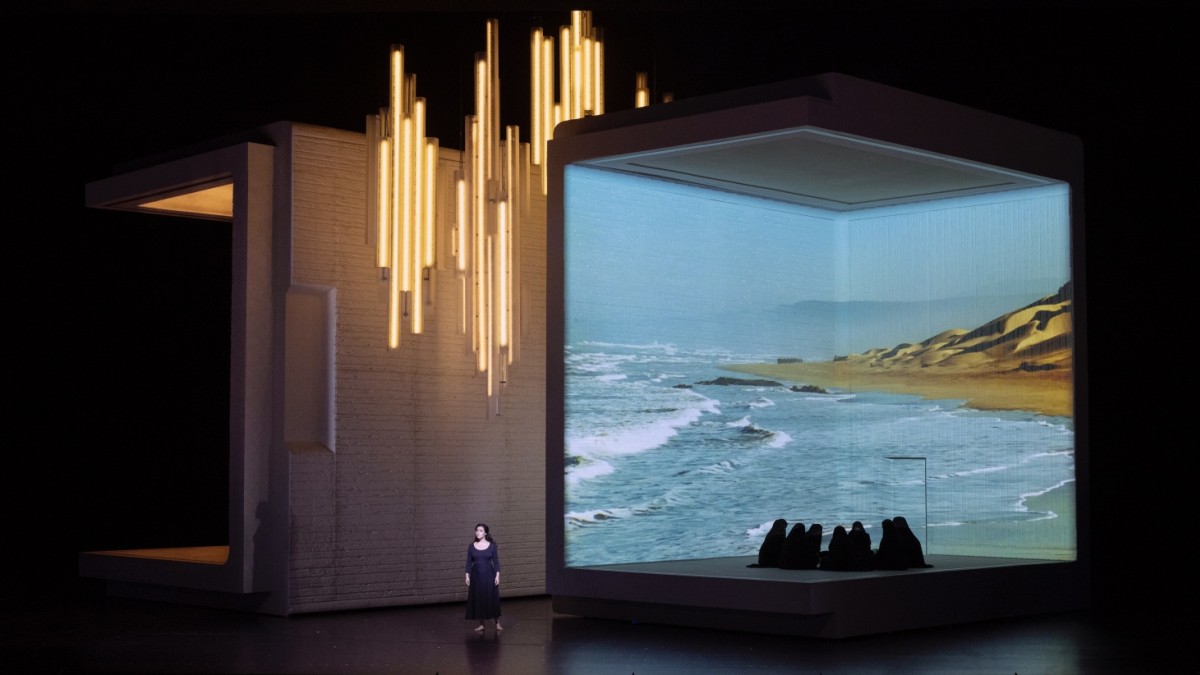The procedure is particularly uncommon for the Salzburg Festival because it involved the staging of Verdi’s “Aida” in 2017 by Iranian photographer and filmmaker Shirin Neshat. It wasn’t really related to directing operas, but it was her first position as an opera director. I seem to recall the feeling of a lavish concert event. Neshat is now back to update her prior work. In fact, she now incorporates her own video works, films, and engaging portraits with exceptional image quality into the very center of her artistic work. She still doesn’t understand leadership, though.
She allegedly wanted to work extensively with video as early as 2017, but conductor Riccardo Muti’s opposition prevented this. That is what is said. Sounds reasonable considering that curiously clad persons are currently passing past the stage edge at the Großer Festspielhaus before the music begins (Ku Klux Klan? Good Friday in Spain? Christmas trees in black? They enter the theater with a bowl of incense and continue to do so as a foreboding sign. Between scenes, the music frequently stops, you see grimy images of people, and you can hear chirping whispers. That may have a good appearance, but it is really a tacky declaration of Neshat’s desire to win over everyone.
The films from Neshat’s earlier works (“Passage,” “Rapture”) that can be watched throughout the performance and are primarily in black and white are more profound. sequences on a citadel with the same women and men wearing white shirts and black pants, who appear like something out of a Camus film, feature women dressed in black, sometimes in a group with self-confidence, other times looking like mourners torn in sorrow. a little boat with women floating helplessly out to sea, a beach, a desert. Although the visuals have a lot of mood and occasionally even help the audience make a strong correlation between what is happening on stage and the images, the overall feeling is still one of viewing a video installation with a few random actual people milling around. The war that is already happening on the outskirts of Europe can only be perceived as a menacing aura of oppression and brutality in “Aida,” which is also about the conflict between Egypt and Ethiopia. The revision by Shirin Neshat will never be revised. and is still loudly jeered.
Opera is not solely about beautiful aesthetics. The amazing stage design by Christian Schmidt, a sizable cube that can be split in half and opened, can now be utilized as a projection screen. However, not much occurs within or around it. Clergymen of all stripes who, at least this is obvious, possess the power in their hands are arranged in opulently crafted costumes that seem like a luxury edition of the Oberammergau Passion Play during choral masses. The military in this place is merely a tool of the religious authority, and Radamès is not a hero but rather a young warrior who must carry out orders. Piotr Beczala makes his acting debut in the part; at first, he seems tense, but by the end, he is in charge; he cannot portray love, and he is rarely close to Aida.
Ve-Maud Hubeaux, a mezzo-soprano, enters as Amneris and moves the audience.
The Vienna Philharmonic is led by Alain Altinoglu in just two physical states: loud and quiet. Quiet is alluring, while loudness is uniform and undifferentiated. Particularly when paired with Elena Stikhina, who as Aida has a lovely pianissimo, otherwise totally understands her part, and vanishes when she is not singing. In 2017, Anna Netrebko played the role of Aida. She brought the production’s statues to life and wore an outfit that resembled an ancient Egyptian sculpture. Stikhina is dressed in a plain black outfit. That makes their presence less helpful. By filling the void left by the lack of any game notion as a southern Italian mafia leader rather than an Ethiopian monarch, Luca Salsi, who sings Aida’s father Amonasro, helps himself in a practical way.
On stands out. Early in August, Ve-Maud Hubeaux learned that she would be singing Amneris. Your intervention is a victory. She dominates the stage with her physical presence, loves and suffers, and is a real person with a voice and flesh and blood. Everyone else vanishes in her shadow.
And then there is a brief instant when the scene and the music fuse to create theater. The monks encourage the gullible people to go to battle, Verdi cries for war violently (“Guerra!”), but here the people are worn out. No passion, and definitely not for a conflict. That almost serves as solace.
